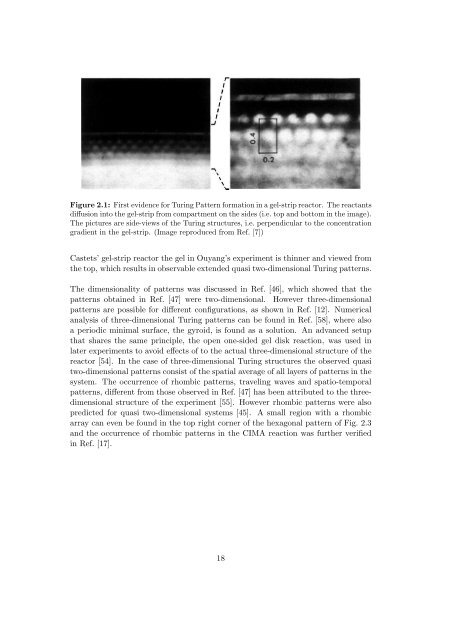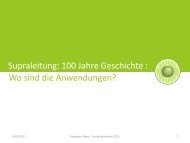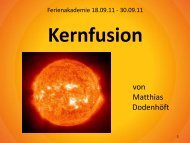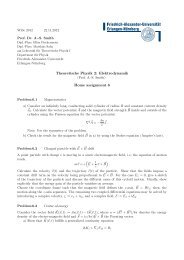Morphology of Experimental and Simulated Turing Patterns
Morphology of Experimental and Simulated Turing Patterns
Morphology of Experimental and Simulated Turing Patterns
You also want an ePaper? Increase the reach of your titles
YUMPU automatically turns print PDFs into web optimized ePapers that Google loves.
Figure 2.1: First evidence for <strong>Turing</strong> Pattern formation in a gel-strip reactor. The reactantsdiffusion into the gel-strip from compartment on the sides (i.e. top <strong>and</strong> bottom in the image).The pictures are side-views <strong>of</strong> the <strong>Turing</strong> structures, i.e. perpendicular to the concentrationgradient in the gel-strip. (Image reproduced from Ref. [7])Castets’ gel-strip reactor the gel in Ouyang’s experiment is thinner <strong>and</strong> viewed fromthe top, which results in observable extended quasi two-dimensional <strong>Turing</strong> patterns.The dimensionality <strong>of</strong> patterns was discussed in Ref. [46], which showed that thepatterns obtained in Ref. [47] were two-dimensional. However three-dimensionalpatterns are possible for different configurations, as shown in Ref. [12]. Numericalanalysis <strong>of</strong> three-dimensional <strong>Turing</strong> patterns can be found in Ref. [58], where alsoa periodic minimal surface, the gyroid, is found as a solution. An advanced setupthat shares the same principle, the open one-sided gel disk reaction, was used inlater experiments to avoid effects <strong>of</strong> to the actual three-dimensional structure <strong>of</strong> thereactor [54]. In the case <strong>of</strong> three-dimensional <strong>Turing</strong> structures the observed quasitwo-dimensional patterns consist <strong>of</strong> the spatial average <strong>of</strong> all layers <strong>of</strong> patterns in thesystem. The occurrence <strong>of</strong> rhombic patterns, traveling waves <strong>and</strong> spatio-temporalpatterns, different from those observed in Ref. [47] has been attributed to the threedimensionalstructure <strong>of</strong> the experiment [55]. However rhombic patterns were alsopredicted for quasi two-dimensional systems [45]. A small region with a rhombicarray can even be found in the top right corner <strong>of</strong> the hexagonal pattern <strong>of</strong> Fig. 2.3<strong>and</strong> the occurrence <strong>of</strong> rhombic patterns in the CIMA reaction was further verifiedin Ref. [17].18






